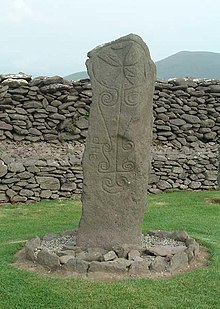Reask
Reask ( Irish An Riasc ) is an early church enclosure (English: Early ecclesiastical enclosure) in which a monastery of the Iroschottischen Church was built. There are no records of any kind about the system. It is located in the east of Ballyferriter in County Kerry on the Dingle Peninsula in Ireland .
The excavations in the 1970s uncovered an irregularly oval dun or cashel. Its surrounding wall is 2.2 m wide in places and up to a height of about one meter. Inside the wall are the remains of several clochans , a stone oratory with a collapsed roof, some other structures, including a rectangular one, and a cemetery with over 40 graves. There is a curved partition wall on the site. The system is particularly known for a number of cross slabs or pillar stones (stone pillars).
Stone A
A stone column, 1.65 m high and more than 0.5 m wide, carries a Greek cross in a circle with attached spiral designs in pelta shape.
Stone B
Stone B is a sandstone slab at the entrance to the oratory. The 0.8 m high stone is 0.4 m wide and 0.2 m thick. It is decorated with a large Latin cross with forked ends. Above the cross there is a horizontal bar with forked ends and above the crossbar of the cross two small Greek crosses are stamped.
Stone C
Stone C is a sandstone slab decorated with a Latin cross.
Stone D
Stone D is decorated on both sides with Latin crosses and letters. The 1.14 m high, 0.18 m wide and 0.14 m thick stone is a slender sandstone pillar.
Stone E.
Stone E (now in the National Museum) is a sandstone slab with a Greek cross.
Stone F
Stone F was taken to University College in Cork and is decorated with Latin crosses on both sides.
The beehive huts
The beehive huts A and B (Irish: Clochán A and B) are combined into an eight-shaped floor plan. Clochan A has a diameter of 5.5 and Clochan B 6.0 m. These two huts and the oratory were connected by a paved path up to the intermediate wall.
Clochans C and D are assembled as circles and are accessed through a shared entrance. Clochan D with a diameter of 4.5 m has installed large slabs in the lower area of the dry masonry. There are post stones on one side of the entrance and between the clochans.
literature
- Steve MacDonogh: The Dingle Peninsula: History, Folklore and Archeology . Brandon, 1993 ISBN 0-86322-159-9
Individual evidence
- ↑ Pelten are ivy leaf-like ornaments with a pointed apex and volute-like twisted endings. In Greece they occur mainly on late antique mosaics and plasters
Web links
Coordinates: 52 ° 10 ′ 2.7 ″ N , 10 ° 23 ′ 16 ″ W.

